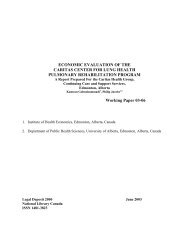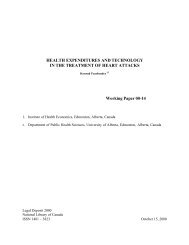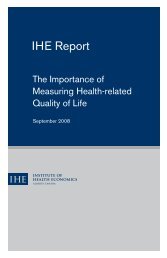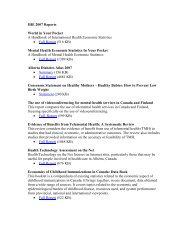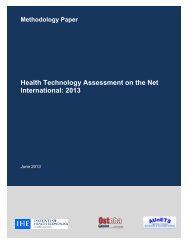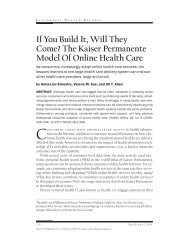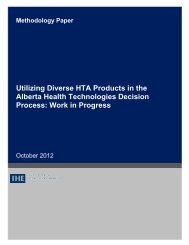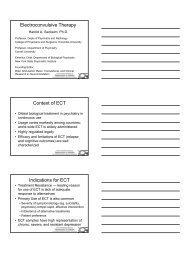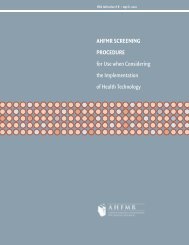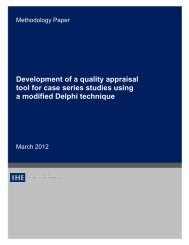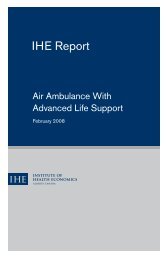Bariatric treatments for adult obesity - Institute of Health Economics
Bariatric treatments for adult obesity - Institute of Health Economics
Bariatric treatments for adult obesity - Institute of Health Economics
- No tags were found...
Create successful ePaper yourself
Turn your PDF publications into a flip-book with our unique Google optimized e-Paper software.
methods, meal planning, and exercise. The study adopted a societal perspective and was conductedover a 1-year horizon. The direct cost was the time cost spent by the GPs and dieticians, and theindirect cost was the time cost spent to attend the nutritional counselling. Results indicated that, ascompared to no counselling, the cost was $1487 per LY saved and $10,858 per LY saved <strong>for</strong> GP anddietician counselling, respectively. For patients without IHD, as compared to no counselling, thecost decreased to $845 per LY saved and $4248 per LY saved, respectively. The study concludedthat nutritional counselling by a GP or a dietician was cost-effective <strong>for</strong> obese patients with a highrisk <strong>of</strong> IHD, and that intervention by a GP was superior to that by a dietician.Tsai et al. 29 used data from an RCT enrolling 132 patients to evaluate the cost-effectiveness <strong>of</strong> LCDin comparison with standard diet <strong>for</strong> the treatment <strong>of</strong> patients with severe <strong>obesity</strong> (BMI ≥ 43kg/m 2 ). The time horizon <strong>of</strong> the study was 12 months. The study adopted a societal perspective inthe US. Patients in study and control groups received weekly counselling sessions during the firstmonth and monthly sessions over the next 5 months. Patients in the LCD group were counselled toconsume less than 30 grams per day <strong>of</strong> carbohydrate, while those in control group were counselledto follow the National Cholesterol Education Program Step 1 diet. Direct medical costs included thecosts <strong>of</strong> time spent by dieticians, physician visits, and laboratory tests. The productivity costconsidered in the analysis was the cost <strong>of</strong> lost work time. The base-case analysis showed that LCDgenerated an additional QALY <strong>of</strong> 0.04 at a lower cost. However, results from a bootstrap analysisindicated the difference in costs and QALYs was not statistically significant between comparators.The study, there<strong>for</strong>e, concluded that LCD was not more cost-effective <strong>for</strong> weight loss, as comparedto the standard diet.Sevick et al. 30 used an RCT enrolling 318 patients to conduct a cost-effectiveness analysis <strong>of</strong> diet,exercise, and a combination <strong>of</strong> diet and exercise, as compared to LM, <strong>for</strong> the treatment <strong>of</strong> elderlypatients aged ≥ 60 years with a BMI ≥ 28 kg/m 2 and knee osteoarthritis. The study was conductedfrom a payer’s perspective over an 18-month horizon. The costs considered in the analysis includedhome visits, dietary classes, telephone time, gym space, and equipment. Results indicated that,compared to lifestyle control, the cost per percentage <strong>of</strong> baseline body weight loss was $37, $50, and$63, <strong>for</strong> diet, exercise, and combined diet and exercise, respectively. The study concluded thatcombined exercise and diet was the most cost-effective option to improve physical function, pain,and stiffness <strong>for</strong> obese patients with knee osteoarthritis.Galani et al. 31 constructed a Markov model to assess the economic impact <strong>of</strong> an LM <strong>for</strong> preventingand treating <strong>obesity</strong>, compared to standard care. The study population comprised individuals aged ≥25 years with a BMI between 25 kg/m 2 and 35 kg/m 2 and examined three sub-groups based on BMIlevels: overweight with a BMI 25 kg/m 2 to 29.9 kg/m 2 ; moderately obese with a BMI 30 to 35 kg/m 2 ; borderline with a BMI 30 kg/m 2 .The model adopted a societal perspective and was conducted in Switzerland over a lifetime horizon.Individuals in the LM group attended dietician and supervised exercise sessions during the first 3years and undertook moderate daily exercise <strong>for</strong> at least 30 minutes. Standard care consisted <strong>of</strong> basicdietary counselling and physical exercise sessions <strong>for</strong> obese patients, and no intervention <strong>for</strong>overweight patients. Clinical evidence came from published cohort studies and RCTs. The costs <strong>of</strong>interventions and <strong>obesity</strong>-related morbidities, including hypertension, T2DM, hypercholesterolaemia,coronary heart disease, and stroke, were considered. Results were reported over a range <strong>of</strong> age/sex<strong>Bariatric</strong> <strong>treatments</strong> <strong>for</strong> <strong>adult</strong> <strong>obesity</strong> 169



